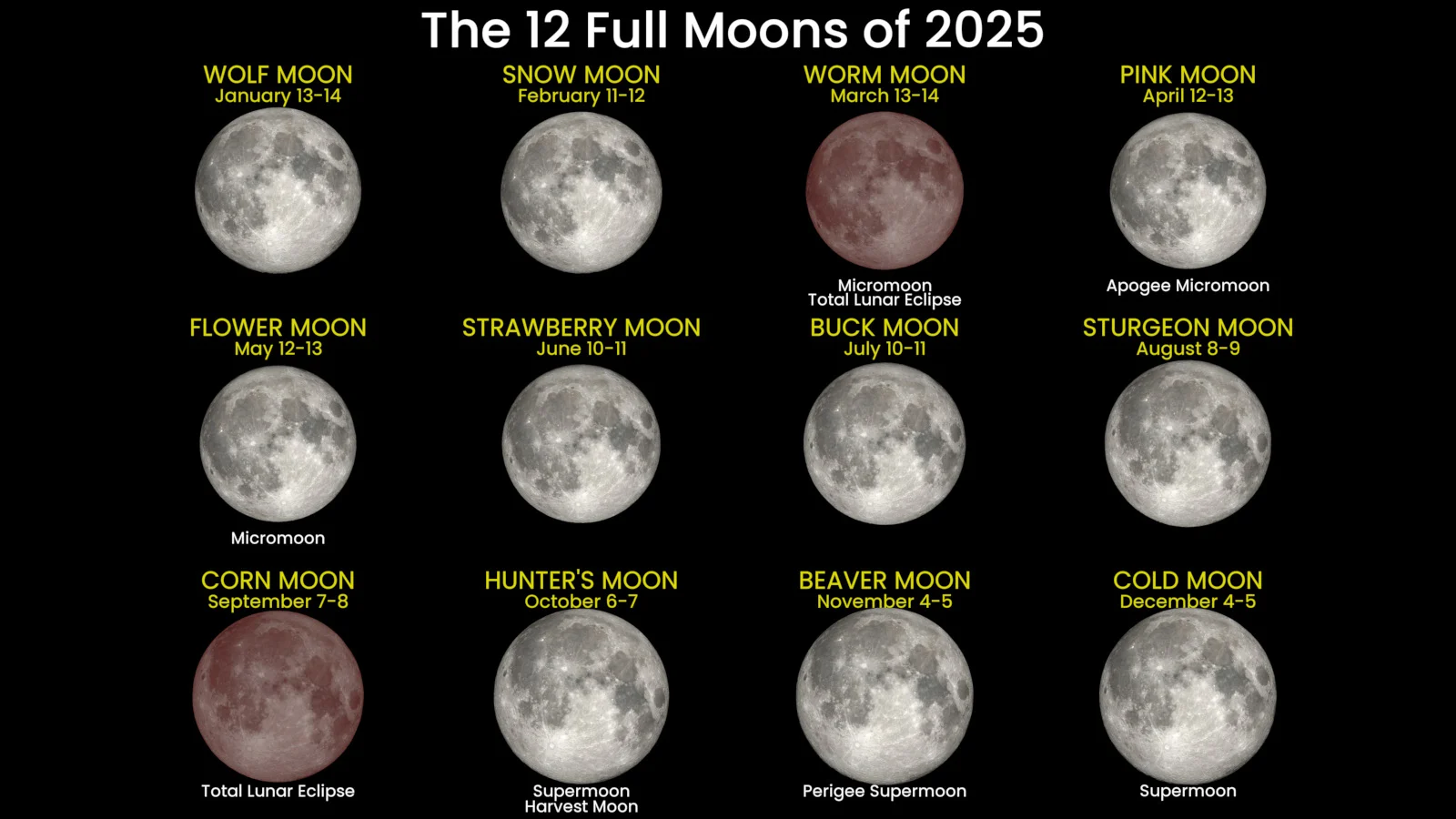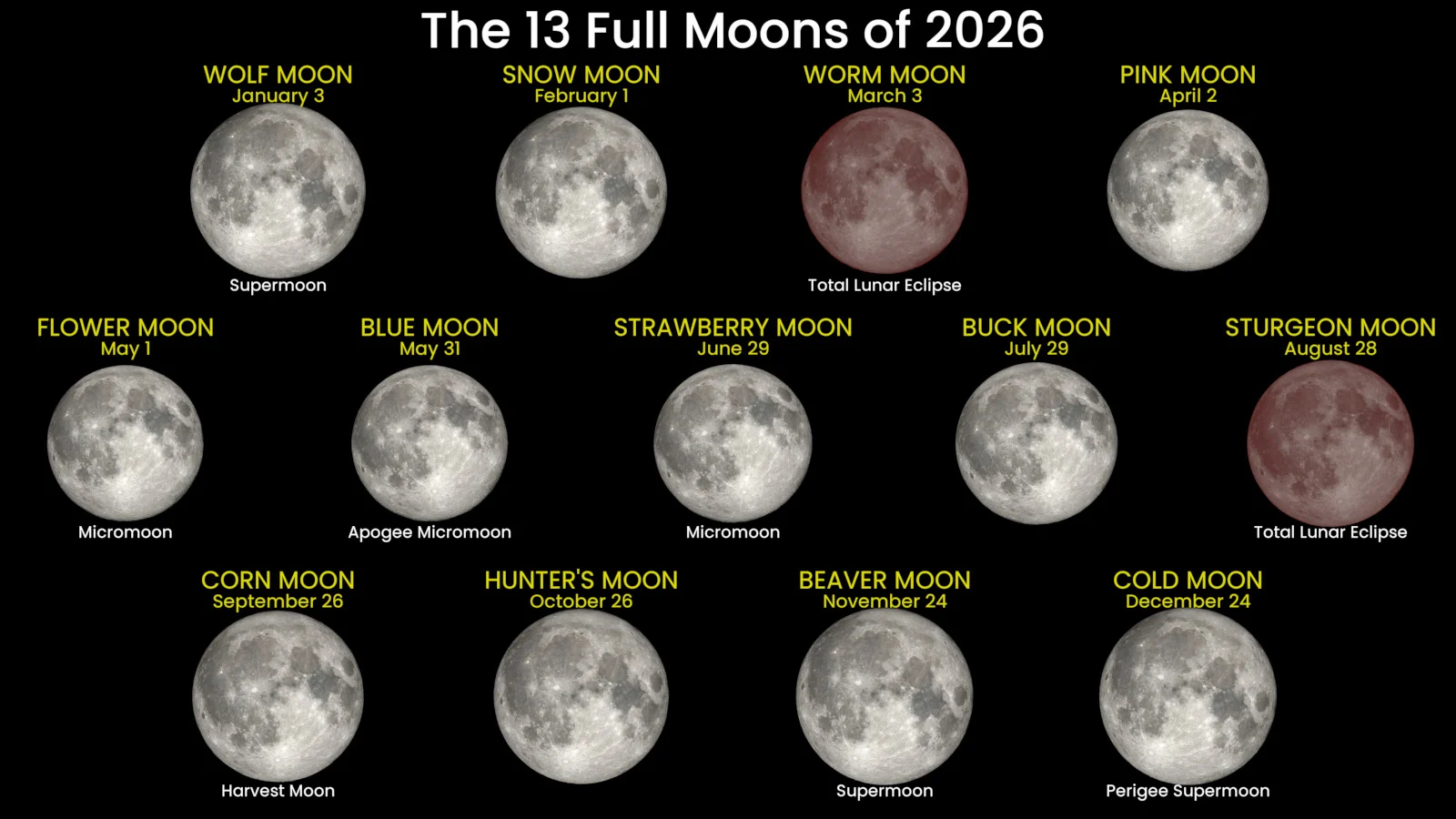
The biggest, brightest Supermoon of 2025 rises tonight!
The Full Beaver Moon will shine in the sky Tuesday night, as the biggest and brightest November Full Moon in nearly nine years!
Eyes to the sky, Tuesday night, to see 2025's Perigee Supermoon brighten up our November sky.
Overnight from Tuesday to Wednesday, November 4-5, the Sun, Earth, and Moon will align in syzygy, with the Earth-facing side of the Moon fully illuminated by the Sun.
Of all the 12 Full Moons that occur during 2025, this is the closest and largest of all. Even more noticeable, though, it will be the brightest of all, at roughly 30 per cent brighter than the smallest and most distant Full Moon of the year, which we saw back in April.

The November 2025 Perigee Supermoon is significantly larger than the April Apogee Micromoon, due to being roughly 50,000 kilometres closer to Earth. (NASA's Scientific Visualization Studio/Fred Espenak/Scott Sutherland)
If you would like to see this Full Moon look substantially larger than it truly is, seek it out in the sky just after moonrise or just before moonset, when it is low on the horizon. The perspective of the far-distant Moon hanging just above the landscape plays a little 'trick' on our brains, making it appear huge in the sky.
What is a Perigee Supermoon?
As the Moon orbits around Earth, it doesn't trace out a perfect circle. Instead, it follows a slightly elliptical path. So, for roughly half of each orbit, the Moon is closer to Earth, and for the rest, it is farther away. It also passes through a closest distance to Earth (perigee) and a farthest distance from Earth (apogee).
Due to the gravity of the Sun and the other planets in the solar system tugging on Earth and the Moon over time, the exact shape of the Moon's orbit changes. As a result, each time it goes around us, its perigee and apogee distances also change. The exact timing of perigee and apogee don't always work out to be right at Full Moon. Most often, they occur at some other point of the Moon's phases.
However, once per year, there is a Full Moon that occurs closest to when the Moon is at its perigee, and there is another that happens when the Moon is closest to apogee. Appropriately, these are the Perigee and Apogee Full Moons.

The relative distances of the closest Full Moon (Nov 4-5) and farthest Full Moon (April 12-13) for 2025. Both the Earth and Moon are shown at 3x their normal size. (NASA's Scientific Visualization Studio/Fred Espenak/Scott Sutherland)
Unlike 'perigee', the term 'supermoon' doesn't originate from astronomy. Instead, it was coined by astrologer Richard Nolle, in 1979.
Nolle defined a supermoon as "a new or full moon which occurs with the Moon at or near (within 90 per cent of) its closest approach to Earth in a given orbit (perigee)."
All told, there are typically between 7 and 9 supermoons in any given year. So, they aren't exactly rare. In 2025, there are nine, which includes the five New Moons from February through June, and also the four Full Moons from September through December. There is even a fifth Full supermoon in the 'string', as well, but it occurs in January of 2026.
However, there is only one Full Perigee Supermoon each year. So, spare a few moments on Tuesday night to head outside and check it out!
READ MORE: Why is the supermoon so compelling to us?
What is the Beaver Moon?
November's Full Moon is often referred to as the Beaver Moon.
This name comes from a list of Moon names first penned in the Farmer's Almanac well over a century ago. They were taken from European and settler folklore, as well as the lunar calendar used by the Indigenous peoples from what is now the northeastern United States and the Great Lakes region.

This graphic collects all the relevant data about each of the 12 Full Moons of 2025, including their popular names, whether they are a 'super' or 'micro' Moon, a 'perigee' or 'apogee' Moon, and whether they are remarkable in some other way (Harvest Moon, lunar eclipse, etc.). Credit: Scott Sutherland/NASA's Scientific Visualization Studio/Fred Espenak
According to The Old Farmer's Almanac: "This is the time of year when beavers begin to take shelter in their lodges, having laid up sufficient food stores for the long winter ahead. During the fur trade in North America, it was also the season to trap beavers for their thick, winter-ready pelts."
Other Indigenous names for this Moon are Digging (or Scratching) Moon (Tlingit), Deer Rutting Moon (Dakota and Lakota), Whitefish Moon (Algonquin), Frost Moon (Cree and Assiniboine) and Freezing Moon (Anishinaabe).
Indigenous Moons
In popular culture, today, these names are used only to refer to the Full Moons. However, they are actually part of the lunar calendar the Indigenous peoples of North America used to track the passage of time throughout the year. Each name, therefore, referred to one full cycle of the Moon, from one New Moon to the next.

The phases of the Beaver Moon in 2025. (NASA SVS/Scott Sutherland)
"From the Full Moon cycles, it was noted that certain things happened in the environment. The weather, plants, animals and temperature seemed to follow the cycles of the Moon. One of the patterns that became apparent was that there were 13 Full Moons that occurred before everything seemed to start all over again. Thus a 13 Moon cycle was identified," Wilfred Buck, Researcher and Knowledge Keeper of the Opaskwayak Cree Nation, wrote on the Canadian Space Agency website.
"When Europeans made contact with the First Nations peoples of the Americas, it was evident that some Indigenous peoples followed a lunar calendar depicted on the back of a turtle's shell. Turtle shells have 28 smaller outer edge scutes, representing the number of days from one full Moon to the next, and 13 larger central scutes, representing the 13 moon cycles. The turtle (Mikinak Ministik) held a special place in the various cultures of Indigenous people," Buck explained.
Watch below: Wilfred Buck explains Makinak, the living calendar of the Indigenous peoples.
The 13 Moons of the Opaskwayak Cree Nation are:
Kitci Pisim/Mistapiw Pisim (Great Moon/Giant Moon),
Mikisiw Pisim (Eagle Moon),
Niska Pisim (Goose Moon),
Anikis Pisim (Frog Moon),
Sakipakawi Pisim (Budding Moon),
Opaskawiowi Pisim/Ota'imin Pisim (Hatching Moon/Heart Berry Moon),
Paskowi Pisim/Eyapay Apusci Mooswa Pisim (Moulting Moon/Buck Moon),
Opaowi Pisim/Namiw Pisim (Flying Up Moon/Sturgeon Moon),
Pisim/Ininiw Nipin Pisim (Mating/Rutting Moon/Indian Summer Moon),
Kaskatinowi Pisim (Freezing Up Moon),
Nikopiwi Pisim/Pipoon Nikititicikiw Pisim (Frosting Up Moon/Winter Keeper Moon),
Pawacikwanasis Pisim/Mikan Pisim (Blizzard Wind Moon/Wolf Moon), and
Opawacakinasisi Pisim (Frost Exploding Moon).
DON'T MISS: Why does the Moon look so big? What is the mysterious Moon Illusion?
13 Moons? Not 12?
The reason why there are 13 Moons in the lunar calendar used by the Indigenous peoples (as well as other cultures, such as the Norse) is because that's roughly how many 28-day lunar cycles there are in a 365 day year.
By the Gregorian calendar, it's easy to think of there being 12 Full Moons during the year, with one for every month. However, during a year when the first Full Moon occurs close to the beginning of January, there will be 13 Full Moons in that year.

The Full Moons of 2026, including their popular names, dates, and remarkable aspects (supermoon, micromoon, apogee or perigee moon, harvest moon, eclipses, etc.). (NASA SVS/Fred Espenak/Scott Sutherland)*
This occurred in 2020 and 2023, and it happens again in 2026, 2028, 2031, etc. In each of those 13-Full-Moon years, the 'extra' Full Moon is a Blue Moon (the second of two Full Moons occurring within the same calendar month).
(Thumbnail image shows the 2021 Beaver Moon, courtesy Harvey Daneluk, who uploaded the picture into The Weather Network's UGC gallery)
